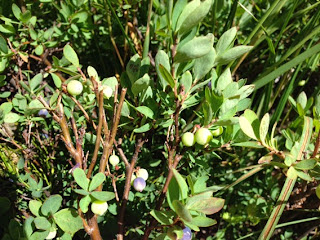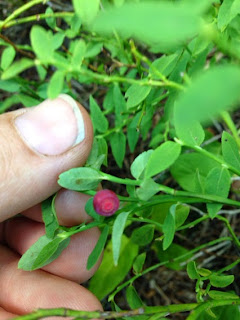 |
| Vaccinium uliginosum var. occidentale |
The branches are round and brown; the leaves are entire (i.e. not toothed) which distinguishes it from most other species in the genus; and the berries are blue and small (4-7 mm in diameter). The berries grow from the leaf axils, often singular, but are also found in clusters of 2-4. The flavor is not as good as real huckleberries, but still very good, both juicy and sweet. Collecting them can be rather hit-and-miss, because many bushes will have few or no fruit (perhaps having already been picked clean by wildlife), while occasionally a bush will be found with a lot of berries.
 |
| Vaccinium scoparium |
They are very wide-spread and common, but the berries are very small, with just a few per plant, so that picking any good quantity would like quite a while. They are so small that it's hard to get the taste from a single berry; it is much better to pick several and eat them all at once, so you can fully taste them. Nevertheless, despite the tiny size and need to search over a large area of plants, I personally like the flavor of these the best, out of the three berries described here, especially if I can find them in the very ripe stage where they start to turn purpleish.
 |
| Gaultheria humifusa |
Unlike the shrubby plants of Vaccinium, this plant hugs the ground, forming a sparse mat of leaves and red berries. It seems to prefer spots where the soil is too thin for other most other plants, but can also be found growing under the other species described here. It still has woody stems, but they are mostly under the surface, with just few leaves and a berry or two where the stem emerges. The berries are red, fading to white on the underside when less ripe. They are wider around than they are long, and about 5-7 mm in diameter.
The taste is similar to the other berries described here, sweet with a bit of tartness, but these are firmer and less juicy than the others. Even though they are a wintergreen, they do not seem to me to have a strong wintergreen flavor, although there may be a slight suggestion of that in the tartness side of the flavor. Some sources suggest eating the leaves, but when I tried them they were very tough, and did not have a very good flavor.
The taste is similar to the other berries described here, sweet with a bit of tartness, but these are firmer and less juicy than the others. Even though they are a wintergreen, they do not seem to me to have a strong wintergreen flavor, although there may be a slight suggestion of that in the tartness side of the flavor. Some sources suggest eating the leaves, but when I tried them they were very tough, and did not have a very good flavor.





